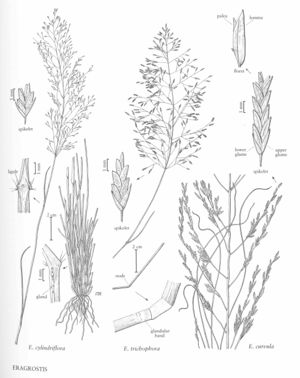Difference between revisions of "Eragrostis trichophora"
FNA>Volume Importer |
imported>Volume Importer |
||
| (4 intermediate revisions by 2 users not shown) | |||
| Line 3: | Line 3: | ||
|accepted_authority=Coss. & Durieu | |accepted_authority=Coss. & Durieu | ||
|publications= | |publications= | ||
| + | |special_status={{Treatment/ID/Special_status | ||
| + | |code=I | ||
| + | |label=Introduced | ||
| + | }} | ||
|basionyms= | |basionyms= | ||
|synonyms={{Treatment/ID/Synonym | |synonyms={{Treatment/ID/Synonym | ||
|name=Eragrostis atherstonei | |name=Eragrostis atherstonei | ||
| − | |authority= | + | |authority= |
| + | |rank=species | ||
}} | }} | ||
|hierarchy=Poaceae;Poaceae subfam. Chloridoideae;Poaceae tribe Cynodonteae;Eragrostis;Eragrostis trichophora | |hierarchy=Poaceae;Poaceae subfam. Chloridoideae;Poaceae tribe Cynodonteae;Eragrostis;Eragrostis trichophora | ||
| Line 19: | Line 24: | ||
-->{{Treatment/Body | -->{{Treatment/Body | ||
|distribution=Md. | |distribution=Md. | ||
| − | |discussion=<p>Eragrostis trichophora is native to Africa, where it often grows in moist, disturbed or overgrazed sites. It has been collected from disturbed sites at Canton, Maryland.</p> | + | |discussion=<p><i>Eragrostis trichophora</i> is native to Africa, where it often grows in moist, disturbed or overgrazed sites. It has been collected from disturbed sites at Canton, Maryland.</p> |
|tables= | |tables= | ||
|references= | |references= | ||
| Line 28: | Line 33: | ||
-->{{#Taxon: | -->{{#Taxon: | ||
name=Eragrostis trichophora | name=Eragrostis trichophora | ||
| − | |||
|authority=Coss. & Durieu | |authority=Coss. & Durieu | ||
|rank=species | |rank=species | ||
| Line 35: | Line 39: | ||
|basionyms= | |basionyms= | ||
|family=Poaceae | |family=Poaceae | ||
| − | |illustrator=Linda A. Vorobik | + | |illustrator=Linda A. Vorobik;Cindy Roché |
| + | |illustration copyright=Utah State University | ||
|distribution=Md. | |distribution=Md. | ||
|reference=None | |reference=None | ||
|publication title= | |publication title= | ||
|publication year= | |publication year= | ||
| − | |special status= | + | |special status=Introduced |
| − | |source xml=https:// | + | |source xml=https://bitbucket.org/aafc-mbb/fna-data-curation/src/200273ad09963decb8fc72550212de541d86569d/coarse_grained_fna_xml/V25/V25_115.xml |
|subfamily=Poaceae subfam. Chloridoideae | |subfamily=Poaceae subfam. Chloridoideae | ||
|tribe=Poaceae tribe Cynodonteae | |tribe=Poaceae tribe Cynodonteae | ||
Latest revision as of 18:55, 11 May 2021
Plants perennial; cespitose, stoloniferous, forming innovations near the base. Culms 30-70 cm, erect, geniculate, or prostrate, often rooting at the lower nodes, glabrous, with a ring of glands below the nodes. Sheaths glabrous or with scattered papillose-based hairs over most of the surface, apices pilose, hairs 1-4 mm, a ring of oblong glands sometimes present below the collar; ligules 0.2-0.5 mm; blades 1.4-10 cm long, 2-3 mm wide, flat to involute, sparsely hairy with papillose-based hairs, abaxial surfaces often with glandular dots. Panicles 5-20 cm long, 2-7 cm wide, narrowly ovate, open; primary branches 2-7 cm, diverging 10-70° from the rachises, lowest branches whorled, naked proximally, bases with a glandular band; pulvini hairy; pedicels 0.3-3.3 mm, glandular. Spikelets 4-5.4 mm long, 1-1.5 mm wide, linear-lanceolate, plumbeous to greenish-gray, with 3-5 florets; disarticulation acropetal, paleas persistent. Glumes subequal, 1.4-1.8 mm, ovate-lanceolate, membranous; lemmas 1.5-1.8 mm, ovate, membranous, often hyaline, lateral veins inconspicuous, apices obtuse to acute; paleas 1.3-1.7 mm, hyaline, bases not projecting beyond the lemmas, apices obtuse; anthers 3, 0.7-1 mm, purplish. Caryopses 0.6-0.8 mm, ovoid, terete to dorsally compressed, shallowly grooved adaxially, translucent, mostly whitish to light brown, bases often greenish. 2n = unknown.
Distribution
Md.
Discussion
Eragrostis trichophora is native to Africa, where it often grows in moist, disturbed or overgrazed sites. It has been collected from disturbed sites at Canton, Maryland.
Selected References
None.
